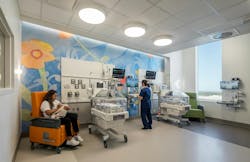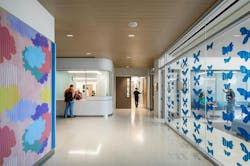Designing for Impact: The Transformation of University Health's Women's & Children's Hospital
Key Highlights
- The hospital’s design prioritizes natural light, earthy colors, and warm materials to create a calming environment that supports emotional well-being.
- Community input and personal experiences shaped key features like couplet care, which set a new precedent in Texas hospital standards.
- The newly designed hospital successfully exceeded birth rate goals, demonstrating the impact of thoughtful, experience-driven healthcare environments.
Forget what you thought a hospital should look or feel like. In San Antonio, one team is rewriting the rules of healthcare design, starting from the ground up. The result is a new kind of space that’s setting a national precedent—one designed not just to treat patients, but to support families, heal communities, and reshape expectations of what a hospital can be. University Health’s Women’s & Children’s Hospital, a collaboration between ZGF and Marmon Mok, blends advanced medical technology with deep emotional intelligence, proving that good design can—and arguably should—have life-changing impact.
They began every conversation with a simple but powerful idea, according to James Woolum, partner at ZGF. In the words of University Health’s former CEO George Hernández, “This hospital should provide a strong foundation for improving health and helping to shape the future for children.” That guiding principle—amplified by robust community engagement—became the project’s North Star, influencing everything from layout to lighting to artwork selection and spatial programming.
Inside the 14-story, 300-bed academic hospital, a 2024 IIDA Healthcare Design Award winner, this ethos comes alive in unexpected ways. Natural light floods patient rooms through oversized windows, while earthy color palettes echo the South Texas landscape. Soft seating, quiet zones, and thoughtfully designed family lounges offer comfort alongside care. Materials such as wood, terrazzo, and stone were chosen not just for durability but for their emotional impact—providing warmth, texture, and a grounded sense of place.
Designed from Experience, for Experience
But beyond the big picture, the details tell a story rooted in lived experience. For Tiffany Long, senior associate at Marmon Mok, this project wasn’t just another day on the job. “I grew up in this community, so the project was very personal for me,” said Long, who’s had four children—including two emergency C-sections and one NICU (neonatal intensive care unit) stay. She knew how important it was to get this right.
That perspective gave her rare insight into what design decisions truly matter in moments of high-stress or uncertainty—especially for new mothers and their families. Her firsthand experience helped shape everything from the layout of postpartum suites to NICU access and circulation pathways designed to minimize stress.
One of the project’s most impactful design shifts was the push for couplet care—a model that allows mothers and newborns to remain together in the same room, even following surgical births. “Historically, hospitals separated babies from mothers due to antiquated building codes,” Long explained. “We worked with University Health and the Texas Health and Human Services licensing division to secure a waiver that allowed us to design differently.”
The waiver—over 1,000 pages of research, testimonials, and regulatory negotiation—ultimately changed the Texas building code, paving the way for a new standard in postpartum care. Rather than dedicate square footage to mostly empty nursery bays, the design reallocates that space to expand patient rooms and promote mother-baby bonding.
Long had to fight to keep her babies with her. “Having had to demand couplet care myself,” she said, “I knew how important it was.” Now, it’s built into the design. It’s the norm—not the exception. That waiver didn’t just change this hospital—it set a new precedent for others across the state.
Designing for Healing, Inside and Out
How does one balance the clinical demands of a high-tech hospital with the emotional needs of its users? “A project of this size on an existing urban campus came with its challenges. A few come to mind, but one that relates to all health facilities is how to create an environment that is sterile, but also calming and therapeutic,” Long commented. The answer came, in part, through the hospital’s Salud de Arte program and the work of its Child Life department.
More than 600 commissioned artworks by local and regional artists are seamlessly integrated into the space. Think sculptural installations, dynamic wall panels, and even custom-printed rigid wall protections in corridors and patient rooms. These pieces provide more than visual relief; they act as intuitive wayfinding tools and emotional anchors. Research shows that the mind and environment are deeply connected. Art in healthcare spaces doesn’t just make them look better—it helps people feel better.
The hospital’s Child Life department mirrors that philosophy. In addition to celebrating birthdays, engaging siblings, and supporting families during end-of-life care, the team uses creative tools to demystify medical procedures. A good example is the kitten-shaped mock MRI scanner. Long explained that it’s a playful way to help kids understand what’s about to happen. “This toy equipment is used to reduce kids’ fears and help them to understand the treatment they are about to receive,” she said. And it works—initial studies show that children who interact with the scanner are more likely to stay still during the real procedure, reducing the need for sedation and speeding up recovery.
Design That Delivers (Pun Intended)
The results speak volumes: The hospital surpassed its five-year birth goal in just nine months. “University Health has always had excellent physicians and staff,” said Long, but they needed a facility to reflect the quality of care they were providing. Her goal was to design the region’s hospital of choice. “We see these statistics as a mission accomplished!”
With spaces that blend clinical precision and heartfelt care, University Health’s Women’s & Children’s Hospital offers a powerful blueprint for what the future of healthcare design can—and should—look like.
The 2025 IIDA Healthcare Design Awards program is open for submissions through September 9, 2025. Get more details from the IIDA website at iida.org.



